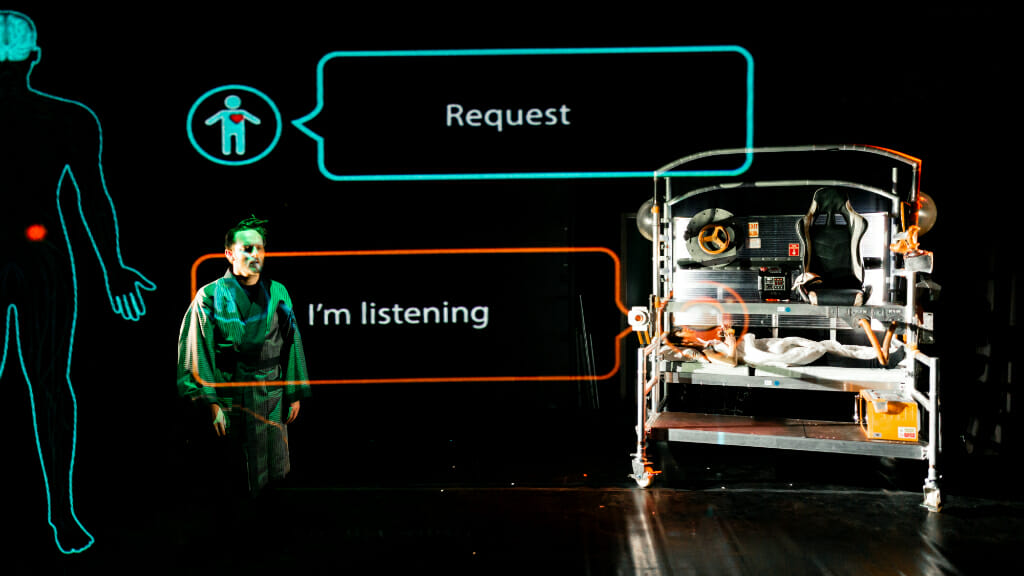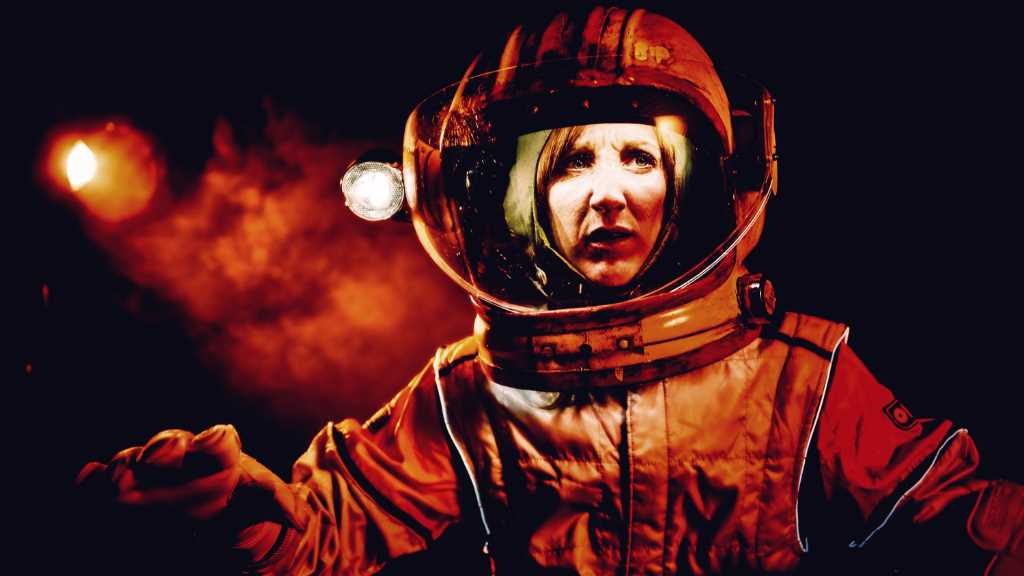Our arts correspondent Will Kemp catches up with Chris Pirie, artistic director of Green Ginger, the innovative theatre company bringing their current show Intronauts to Dartington Live in mid-September.
WK: Tell us about the idea behind Intronauts…
CP: We envisaged a slightly dystopian near-future where people could afford to have a personal cleaner, and have them miniaturised and sent into their body… They could then at will send them to any part of the body – cleaning up organs after a heavy duty weekend of partying, or if they’re not feeling well go and check out that part, so go and clear their throat if they’ve got a sore throat.
So literally, they’re personal cleaners inside the body. We were fascinated by how we would bring that to live action on stage and in a nutshell that’s what we set out to do.

WK: Fascinating! So it’s quite a visual show, you have to represent the body on the stage in some way I assume…
CP: Yes, so Green Ginger have primarily in the last two decades been focusing on visual work. We started as a street theatre company and once we’d moved to indoor, larger scale productions alongside our outdoor and street theatre work, the indoor work has been primarily vision led.
We are primarily a design led ensemble – we start with visual ideas and create our own stories from those. Sometimes it can be a singular idea or image that we were just curious about, or a series of images, or potentially a world or environment that we are fascinated in, thinking that it would be a great place to start to build a story from, rather than conventional ways of starting with a story that you already want to tell. We start in a slightly different way but we end up at the same place.
So with Intronauts there were a number of strands that converged. We made a show back in 2005 called Rust which was about a pirate radio station in a submarine out in the Bristol Channel and we never really kicked the submarine bug – making that show, we got totally obsessed with them. Submarines are basically a fantastic vehicle for going to the depths, to strange places or places you wouldn’t ordinarily be able to visit. So that was one strand – we were thinking submarines in the body.
There was a film called Fantastic Voyage made in 1966 which we was nestled away in our memory banks – a science fiction action movie with Donald Pleasance and Raquel Welch. Also as a kid growing up in the 60’s, one of my favourite cartoon strips was The Numbskulls in The Beano – those tiny little homunculi, white coated scientists that lived in the brain of some random guy, and they could operate in ear department, the eyes, the nose, the mouth – so that was a strand.
Also, I guess around the time we started thinking about this show there were a lot of news stories about fatbergs, particularly under London – blobs of cooking fat and baby wipes – we had an early iteration of the story in which we had these miniaturised people sent into the body, but it was into the body of Elvis Presley, who had been cryogenically frozen just before death, and he was actually defrosting too early. Basically the problem was that he had all these fatbergs inside him. I still like it as an idea – and it was definitely our composer Simon Preston was excited about having a musical world that he could just have fun with.
But that idea didn’t make it through the rinser – we probed the world and decided to go a slightly different way with it.

WK: You mention the composer – so there’s original music in Intronauts – can you give us an idea of what else to expect? What is the experience going to be like for people coming to the show? Without giving too much away…
CP: The first thing that people will see is that we are using a number of devices, starting with the physical performers themselves, then there is puppetry – which can be anything that we move around, from large scale scenic elements to more conventional human figures.
The scale goes from what would fit into your hand, to human scale, to larger pieces of wheeled stage machinery which we move around – we treat them all as puppets, we don’t make a distinction. We move them with the same qualities and the same application of focus, breath and everything else we would a human puppet.
And also the third element is a screen that is dividing the performance area from the auditorium, so between us and the audience there’s a very fine mesh screen. It’s a Hologauze: a very fine gauze developed by a Bristol-based company who allowed us to have some gauze to use for our research and development to work out if we could use it. Up until then it had been used by people like Lady Gaga and few other rock and roll performers – they could replicate or even triplicate Lady Gaga so that she could appear a number of times on stage at the same time. It can produce some very weird effects. It’s silver-coated and allows light to be captured by the silver on the fine gauze, but it also allows a lot of light through. Then if you light behind it with conventional stage lighting it will disappear and you can play between those two extremes of video content being displayed clearly or the whole thing to just disappear. It’s challenging for performers for a couple of reasons – you can’t see it so it’s very easy to walk into.
The other thing is the on-stage lighting when we are upstage from this thing. It basically creates a big silver wall so we can’t see the audience at all when we are performing, which is slightly disconcerting. Having now performed this show a number of times, we have come to terms with that and worked out its limitations. It’s always a bit scary putting video in a show – I think there was a period in the 90s when video suddenly became cheap and accessible and a lot of people grabbed it, but brought it into their work for no good reason other than that it was cheap and accessible and without really thinking through where those two – the live action performance and the video – how they can be sewn together in a really meaningful way. I think we all got a bit sick of seeing video crowbarred into a performance where it wasn’t actually adding anything, and now we have one or two generations of young people that have grown up with video and devices and screens as their primary source of entertainment and social interactions, and therefore the way audiences relate to video when they see it is a slightly different thing.
Theatre practitioners have to be really careful and selective about its use – but we found a way. This particular technology we’re playing with now has allowed us to do things in a (I use the word lightly) innovative way. We’re using it very specifically – we made a very hard and fast rule that we wouldn’t use it to be representative of the inside of the body. It’s very good at line artwork and high contrast stuff – it’s a very black and white world so we use it as a video interface or actually as a text interface between the host and his intronaut.
So we have two main characters in the show – a host, who has an intronaut inside him, and they basically communicate through the screen, they speak the text and then it appears as text on this screen, so you get these two layers. This also allows us to reference things like Minority Report where Tom Cruise is able to move things around, and some other games we can do our own version of. We do a little bit of that as a nod to that possibility but we’re not using it to represent the inside of the lungs or us travelling down a blood vessel, or that kind of photographic, realistic representation of journeying inside the body. We use it as more of a suggestive environment – occasionally there are little wisps or lightning strikes that we might use just at certain moments add a textural layer, but everything else is done by live action and wonderful lighting design by Marianne Thallaug Wedset. She has worked very closely with the director to create this world, so the video content is a secondary layer to all of that.
WK: Great stuff. I had one last question – I’ve heard that you studied at Dartington, is that right?
CP: I did – I studied there and so did the director Emma Williams. Emma was on the theatre course back in the day, and I was there in the early 80s doing Art and Design and Social Context. So we’re both excited to be coming back to Dartington with a show we’re both very proud of. I’m sure it will bring up some great memories. It’s a wonderful place to be – I had a great time there from what I remember of it… it was quite a while ago now!
Intronauts kicks off the latest season of Dartington Live shows this autumn. Suitable for 12+, the show runs from Friday 13 September to Sunday 15 September.
